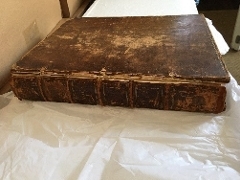John Russell's scrapbook - part two: secrets and discoveries
With the help of scholar and researcher, Dr Timothy Underhill, our Curatorial Assistant, Gemma Haigh, has been discovering more about a scrapbook in our collection that contains drawings by Guildford artist, John Russell RA. Part two of this blog post will explore the discoveries we have made about the object and share some of its many secrets.

The first part of this month's blog post introduced John Russell's fascinating scrapbook, which is a part of Guildford Heritage Service's collection. The drawings and sketches aren't the only interesting thing about this object though.

John Russell was extremely religious from his 'epiphany' moment in 1764 and recorded much of his religious journey in his diaries. He belonged to the Methodist faction of the Christian Church. Russell and many of his friends believed in influencing others' religious beliefs and converting non-believers. Antje Mathews, who wrote a PhD about Russell, said that "Russell's Methodism exerted an overwhelming influence on his life and work".

We cannot be sure where this old, leather-bound book came from. The book itself is probably older than Russell, so it's possible that it may have been given to him to read. Another option is that he found it on the shelves of his father's book and print shop in Guildford and targeted it for destruction!

One of the texts used to cover parts of Christianity as Old as the Creation has been identified by Dr Underhill as Samuel Collins's 1685 book, A Systeme of Anatomy. It was commonplace for eighteenth century artists to own anatomy books and the practice was taught at the Royal Academy schools. Russell shared his views on the importance of anatomy in his publication, Elements of Painting with Crayons. He also encouraged a little artistic licence to final drawings though, to give a more pleasing finish.

Having travelled to Hull for work, could it be that in his sickness, Russell was thinking of home? Russell died of typhus and was buried at Holy Trinity Church in Hull, which has now been renamed Hull Minster.
Is it just a coincidence that Russell's friends had him buried at a church with the same name as his family church in Guildford?

The blog post was written by Gemma Haigh, Curatorial Assistant.
